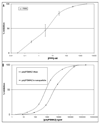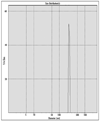Characterization of a targeted nanoparticle functionalized with a urea-based inhibitor of prostate-specific membrane antigen (PSMA)
- PMID: 18698158
- PMCID: PMC3341659
- DOI: 10.4161/cbt.7.6.5968
Characterization of a targeted nanoparticle functionalized with a urea-based inhibitor of prostate-specific membrane antigen (PSMA)
Abstract
Polymeric nanoparticles represent a form of targeted therapy due to their ability to passively accumulate within the tumor interstitium via the enhanced permeability and retention (EPR) effect. We used a combined approach to decorate the surface of a nanoparticle with a urea-based small-molecule peptidomimetic inhibitor of prostate specific membrane antigen (PSMA). PSMA is expressed by normal and malignant prostate epithelial cells and by the neovasculature of almost all solid tumors. This strategy takes advantage of both the avidity of the functionalized nanoparticle for binding to PSMA and the ability of the nanoparticle to be retained for longer periods of time in the tumor due to enhanced leakage via EPR into the tumor interstitium. As an initial step to introducing the targeting moiety, the amino terminus of the small-molecule PSMA inhibitor was conjugated to PEG (M(n) 3400) bearing an activated carboxyl group to obtain a PEGylated inhibitor. Studies undertaken using a radiolabeled PSMA-substrate based assay established that the PEGylated inhibitor had an IC(50) value similar to the uncomplexed inhibitor. Subsequently, nanoparticles loaded with docetaxel were formulated using a mixture of poly(lactide-beta-ethylene glycol-beta-lactide) and PSMA-inhibitor bound alpha-amino-omega-hydroxy terminated poly (ethylene glycol-beta-epsilon-caprolactone). In vitro studies using these nanoparticles demonstrated selective cytotoxicity against PSMA-producing cells. Binding of fluorescently labeled PSMA-targeted particles to PSMA-producing cells has also been directly observed using fluorescence microscopy and observed in secondary fashion using a PSMA substrate based enzyme inhibition assay. Ongoing in vivo studies address the localization, activity and toxicity of these targeted nanoparticles against PSMA-producing human prostate tumor xenografts.
Figures






Similar articles
-
Glutamate-urea-based PSMA-targeted PLGA nanoparticles for prostate cancer delivery of docetaxel.Pharm Dev Technol. 2021 Apr;26(4):381-389. doi: 10.1080/10837450.2021.1875238. Epub 2021 Feb 4. Pharm Dev Technol. 2021. PMID: 33538232
-
111In- and IRDye800CW-Labeled PLA-PEG Nanoparticle for Imaging Prostate-Specific Membrane Antigen-Expressing Tissues.Biomacromolecules. 2017 Jan 9;18(1):201-209. doi: 10.1021/acs.biomac.6b01485. Epub 2016 Dec 21. Biomacromolecules. 2017. PMID: 28001364 Free PMC article.
-
PEG-PLA nanoparticles decorated with small-molecule PSMA ligand for targeted delivery of galbanic acid and docetaxel to prostate cancer cells.J Cell Physiol. 2020 May;235(5):4618-4630. doi: 10.1002/jcp.29339. Epub 2019 Oct 31. J Cell Physiol. 2020. PMID: 31674023
-
Lipid-polymer hybrid nanoparticles as a new generation therapeutic delivery platform: a review.Eur J Pharm Biopharm. 2013 Nov;85(3 Pt A):427-43. doi: 10.1016/j.ejpb.2013.07.002. Epub 2013 Jul 17. Eur J Pharm Biopharm. 2013. PMID: 23872180 Review.
-
Inhibitors of prostate-specific membrane antigen in the diagnosis and therapy of metastatic prostate cancer - a review of patent literature.Expert Opin Ther Pat. 2021 Jun;31(6):525-547. doi: 10.1080/13543776.2021.1878145. Epub 2021 Apr 16. Expert Opin Ther Pat. 2021. PMID: 33459068 Review.
Cited by
-
In vitro targeted photodynamic therapy with a pyropheophorbide--a conjugated inhibitor of prostate-specific membrane antigen.Prostate. 2009 May 1;69(6):585-94. doi: 10.1002/pros.20909. Prostate. 2009. PMID: 19142895 Free PMC article.
-
PET imaging in prostate cancer: focus on prostate-specific membrane antigen.Curr Top Med Chem. 2013;13(8):951-62. doi: 10.2174/1568026611313080008. Curr Top Med Chem. 2013. PMID: 23590171 Free PMC article. Review.
-
A modular strategy to prepare multivalent inhibitors of prostate-specific membrane antigen (PSMA).Oncotarget. 2011 Dec;2(12):1244-53. doi: 10.18632/oncotarget.415. Oncotarget. 2011. PMID: 22207391 Free PMC article.
-
Anti-tumor effects of a recombinant anti-prostate specific membrane antigen immunotoxin against prostate cancer cells.BMC Urol. 2017 Feb 13;17(1):14. doi: 10.1186/s12894-017-0203-9. BMC Urol. 2017. PMID: 28193277 Free PMC article.
-
68Ga-labeled inhibitors of prostate-specific membrane antigen (PSMA) for imaging prostate cancer.J Med Chem. 2010 Jul 22;53(14):5333-41. doi: 10.1021/jm100623e. J Med Chem. 2010. PMID: 20568777 Free PMC article.
References
-
- Jemal A, Siegel R, Ward E, Murray T, Xu JQ, Smigal C, Thun MJ. Cancer statistics, 2006. CA Cancer J Clin. 2006;56:106–130. - PubMed
-
- Crawford ED, Eisenberger MA, McLeod DG, Spaulding JT, Benson R, Dorr FA, Blumenstein BA, Davis MA, Goodman PJ. A controlled trial of leuprolide with and without flutamide in prostatic carcinoma. N Engl J Med. 1989;321:419–424. - PubMed
-
- Yagoda A, Petrylak D. Cytotoxic chemotherapy for advanced hormone-resistant prostate cancer. Cancer. 1993;71:1098–1109. - PubMed
-
- Petrylak DP, Tangen CM, Hussain MH, Lara PN, Jones JA, Taplin ME, Burch PA, Berry D, Moinpour C, Kohli M, Benson MC, Small EJ, Raghavan D, Crawford ED. Docetaxel and estramustine compared with mitoxantrone and prednisone for advanced refractory prostate cancer. N Engl J Med. 2004;351:1513–1520. - PubMed
-
- Tannock IF, de Wit R, Berry WR, Horti J, Pluzanska A, Chi KN, Oudard S, Theodore C, James ND, Turesson I, Rosenthal MA, Eisenberger MA. Docetaxel plus prednisone or mitoxantrone plus prednisone for advanced prostate cancer. N Engl J Med. 2004;351:1502–1512. - PubMed
Publication types
MeSH terms
Substances
Grants and funding
LinkOut - more resources
Full Text Sources
Other Literature Sources
Research Materials
Miscellaneous
